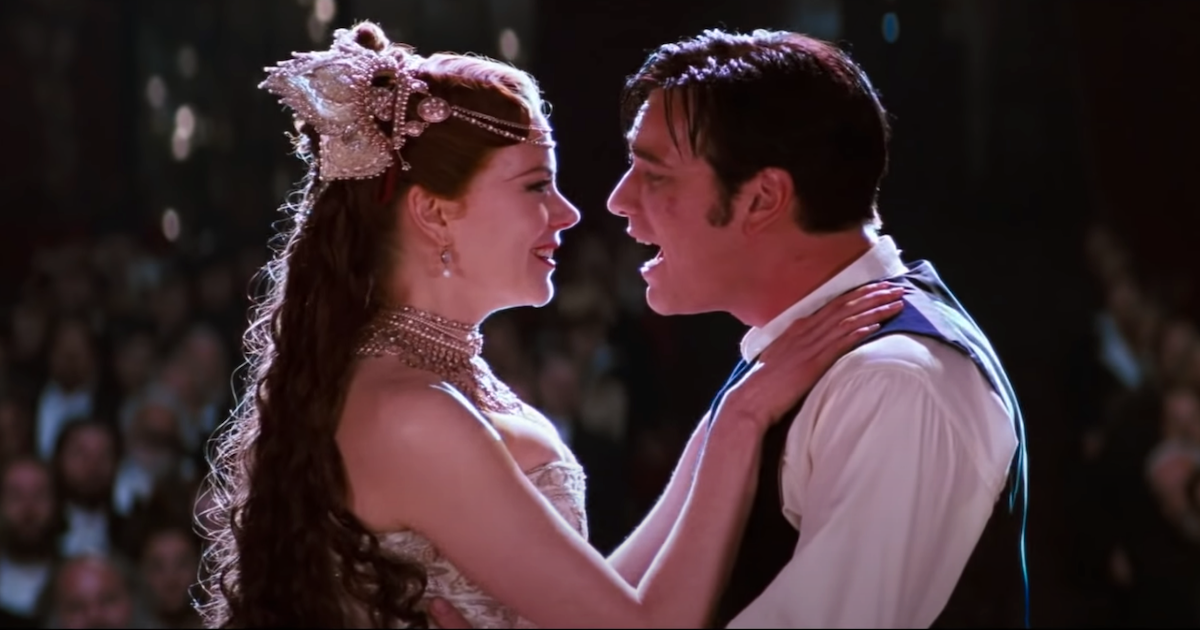Under the masterful artistic direction of Baz Luhrmann, Moulin Rouge hit theaters in 2001. The romantic drama film is a jukebox musical, integrating popular songs from Nirvana, Beck, Madonna, Elton John, and many more. Whereas other jukebox musicals often fail to impress critics, Moulin Rouge won two Academy Awards and was nominated for six others, including Best Picture.
Moulin Rouge is the third and final installment of Luhrmann's Red Curtain Trilogy, an artistic collection that includes his first two films, Strictly Ballroom (1992) and Romeo + Juliet (1996), starring Leonardo DiCaprio and Claire Danes. The first two films also feature flashy props and costumes, elaborate sets, and, of course, romance. Moulin Rouge, however, is the masterful culmination of Luhrmann's previous work.
The film takes place in late 1890s Paris in the town of Montmartre, the epicenter of Bohemian life (along with heavy absinthe consumption and, well, consumption). The Bohemians, including artist Henri de Toulouse-Lautrec (a great John Leguizamo performance), stress the importance of four core values: beauty, freedom, truth, and, above all things, love. The penniless writer, a romantic poet named Christian (Ewan MacGregor), comes to Montmartre to seek the inspiration he lacks: love.
Toulouse sneaks Christian, who is disguised as a wealthy potential investor called The Duke (Richard Roxburgh), into the Moulin Rouge. The Moulin Rouge, French for "Red Windmill," is a nightclub based on the famous cabaret theater of the same name founded by Charles Zidler (Jim Broadbent). Here, Christian discovers his true love in Zidler's star dancer: a courtesan named Satine (Nicole Kidman). They must keep their affair secret from the formidable Duke and plan Satine's escape to freedom — before it is too late.
Melancholy Among Frivolity
Beyond the vibrant colors, striking costumes, and entertaining musical numbers, Moulin Rouge serves as an allegorical update of the famous Greek mythological tragedy of Orpheus and Eurydice. The Roman poet Virgil's version of the myth is among the more popular, and concerns the legendary poet and musician Orpheus, a son of Apollo and the Greek Muse Calliope. He falls in love with a beautiful woman, Eurydice, who is enchanted by the melodies he sings and the tunes he plays on his lyre.
One day, Eurydice is bitten by a poisonous snake and dies. Orpheus laments his grief with his lyre. Hades is so moved by his emotional performance that he grants Orpheus access to the underworld to retrieve his lost love, but on one condition: as Eurydice follows him out, he must not look back at her. As predicted by cruel fate, Orpheus is so scared she isn't really there that he glances behind him, catching a glimpse of Eurydice one last time, and loses his love to the realm of Hades forever.
In Moulin Rouge, Christian is Orpheus; Toulouse often refers (in innuendo) to his "huge talent," and Christian breaks Satine's hardened exterior with his poetry and beautiful song. Christian, an Englishman, is an outsider from the Bohemian world. Satine, however, is a resident of the Moulin Rouge, which Zidler often calls "The Underworld" as an allusion to the realm ruled by Hades. He tells Satine that she is a creature of the underworld, that she belongs among prostitutes, scantily clad dancers, and greedy men, whether she likes it or not. The equivalent to the snake's slow-acting poison is the consumption, or tuberculosis, which is slowly killing Satine, unbeknownst to Christian.
Satine desperately wants to leave the Moulin Rouge to become "a real actress" and live a happy life with Christian, but Zidler, The Duke, and her worsening illness tie her down. From the very beginning, the audience learns that something is wrong with Satine. The film uses this dramatic irony as a haunting reminder that the carefree happiness will eventually come to an end. The bright Bohemian themes that are reflected in the film's artistry (beauty, freedom, and love) are juxtaposed with the value of truth: the inevitability of loss and sorrow.
A Love Story to Rival All Others
Christian and Satine are determined to "overcome all obstacles" in order to be happy and in love. Against all odds, they finally prevail over the evil Duke, who is blinded by a murderous, jealous rage. In the final scenes, MacGregor and Kidman perform the film's only original song, "Come What May." The beautiful duet was snubbed for an Oscar on a technicality, as Luhrmann had originally written it for Romeo + Juliet. This romantic, tragic tale is comparabale to that of what is arguably the most famous love story in the history of Western literature.
The story of Moulin Rouge itself conforms to Toulouse's strict Bohemian standards. Kidman and MacGregor are beautiful in this film, as is the love they portray. Freedom, entrapment, and thus the illusion of freedom are prevalent themes in the movie; Satine resides in a massive elephant, high above the Moulin Rouge, physically isolated from those below her. She feels stuck at the Moulin Rouge and yearns for something beyond her role as a prostitute in the realm of the underworld. To her, Christian's naivety, pureness of heart, and detachment from the underworld represent freedom.
The musical also embodies truth in its depictions of lies and subsequent revelations. Satine hides her sickness, and Zidler puts her in a position in which she feels she must lie to Christian that she no longer loves him in order to protect him from the fury of the Duke. When Christian eventually uncovers the truth, he and Satine experience love in its purest, happiest form. Of course, most of all, Moulin Rouge is a film about love conquering all. Even upon the death of a loved one, love continues to live on.
Moulin Rouge is a visually stunning and musically satisfying masterpiece, illustrating thoughtful care of cinematography and musical composition and helping make 2001 a great year for movies in the process. Kidman delivers an incredible, heartbreaking performance, and Ewan MacGregor has won the audience over with his charming smile and beautiful voice. Luhrmann pays proper homage to the rouge half of the film's title, putting on display brilliant shades of red, a color often associated with anger, passion, and love. Moulin Rouge is what every jukebox musical should aspire to be and is the perfect curtain call to Luhrmann's romantic trilogy.

.jpg)

